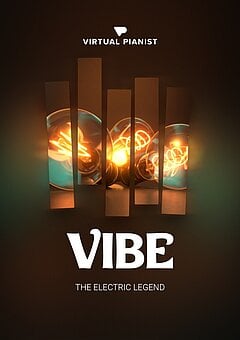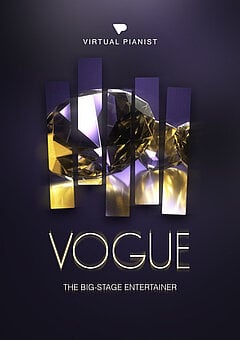How to Use VIBE for Lofi Production
Simple methods to get the perfect electric piano sound for your lofi tracks with no technique or live performance necessary.
DECEMBER 16TH, 2022
Nailing the vibe
When you aren’t certain which instrument or synth to use for chords in a lofi track, electric piano is consistently a great fallback to rely on. Its mellow, dreamy quality makes it a perfect fit for the tone color of this genre, and it doesn’t require any of the complex sound design and parameter tweaking that often comes with synthesis. By nailing electric piano production, you can drastically reduce the amount of time it takes to finish music and bring even more ideas into the world!
Think of the electric piano like a subtle lowpassed synth, only with way more flexibility. Instead of sustaining chords indefinitely at a steady volume level, you can roll or arpeggiate chords to create movement in your harmonies and allow each note to decay naturally and soften over time — this is simply the nature of all real keyboard instruments! Virtual Pianist VIBE allows you to enter simple chords and it will fill out and expand your piano parts for you — more on that in a moment...
The key is to stay as laid back as possible without sacrificing the energy of the track; listen to how quickly the piano notes decay and avoid cluttering the mix with too many at once. Lay down your beat first to get a sense for how everything else will fit in around the kick and snare, and then fill in the electric piano chords accordingly.
How to find the perfect piano part
The first order of business is to sync up your chords and bassline. Get the bare bones sounding just the way you want and throw your beat on top. While this isn’t an absolute must, you can sidechain compress the full mix minus drums off of the kick and snare, which will get the electric piano to pump slightly and bring the listener further into the beat. Now, this begs the question: What do you actually play on the electric piano?
It might be enough to simply hold each chord and let it be — sometimes simplicity is the best course of action. This is especially true if you aren’t a pianist yourself and aren’t comfortable enough to jazz things up. However, this no longer need be a limitation for you, because Virtual Pianist VIBE is here to take care of the fine details! For each chord you play, VIBE will convert it into a fully-fledged piano part based on its wide variety of phrases written and played by professional pianists. The end result is that VIBE interprets pro-quality piano phrases through your chord progressions, giving you a detailed performance without requiring you to actually play anything live!
From here, you can rotate between Styles to see which types of phrases suit your song best, and you’ll find tons of opportunities for variety without even changing a single note! This allows you to test tons of different possibilities quickly, and you can even change the amount of complexity simply by adjusting the Busyness knob; there’s no parallel when it comes to iterating through high-quality piano parts in moments.
Mastering your effects
Electric piano sounds great on its own when it comes to lofi production, but without a few target effects in your processing chain, it won’t quite match up with the rest of the mix. One of the most obvious choices here is saturation, specifically on more of the vintage side. The “right sound” typically involves a little dirt and a gentle rolloff of the high frequencies with a lowpass filter / a dip using a high shelf. One of the quickest ways to accomplish this and have the result fit neatly into the mix is by using Finisher RETRO — this will get you to the sound you want in a very short time, and you can even use it across as many tracks as you choose with varying presets (be sure to change the settings between tracks or the mix will likely begin to sound one dimensional).
If you start pushing the saturation settings, you might notice the instrument begin distorting in an unpleasant way — since the electric piano tends to be midrange-heavy, these frequencies tend to bulk up and hit the saturation before the highs and lows are touched. There are two ways to solve this: either by reducing the saturation drive / gain (which ultimately means less of the effect you want) or by cutting the mids with an EQ. You can often be fairly aggressive with this without it sounding bad, and you’re able to push the effect much harder than you could otherwise without it becoming overpowering.
After saturation, the other effects are more flexible — you can add a delay to create a sense of space or ambience, throw on a reverb, add some tape flutter that plays with the pitch (an effect that RETRO can also help with), and any other odds and ends that shape the instrument into what you’re imagining. Due to the warm and saturated nature of lofi, the spacing doesn’t need to be super realistic, giving you creative freedom to change the effect chain order and push a few boundaries!
Wrapping up
Electric piano is a perfect complement to lofi, especially if you want to shoot for a more organic, “acoustic” quality and add some variety beyond what you can achieve with synthesizers alone. The main challenge producers face is that they’re not experienced pianists themselves and don’t know how to sell the part, which is why VIBE is such a powerful addition to any production arsenal. You don’t even need to know tons of theory ... as long as you’re able to specify the chords you want, VIBE will handle the rest with just a little guidance.
Pair VIBE with Finisher RETRO and you have the perfect pairing for all things lofi — a little saturation and coloring is all you need to take your electric piano parts from straight chords to smooth keys that glue together and polish up a mix in moments!
About the Author
Harry Lodes is a copywriter, marketing consultant and content writer for audio and ecommerce brands. He lives in the Philadelphia area, releasing Eastern/Western hybrid EDM under the artist name KAIRI hearkening back to his roots in Berklee College of Music.
Stay Up To Date
Sign up and we’ll send you an e-mail with product news and helpful stuff every now and then.
Defy Limits
We develop software solutions that enable people to create, consume and interact with music.




